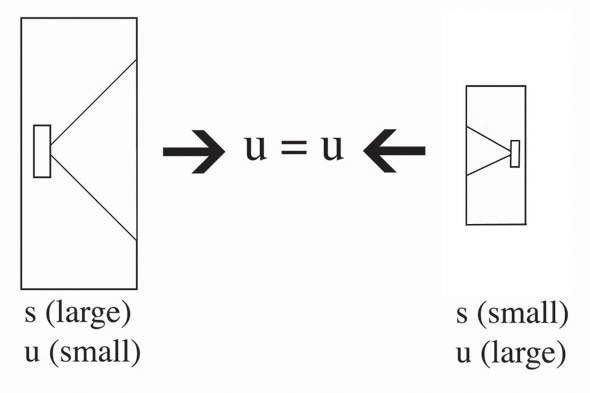
Volume Velocity. The volume velocity (U) in its most simple sense can be considered to be the amount of air that is moved by an acoustic source, such as a loudspeaker, or the amount of air that causes a transducer to move, such as a microphone diaphragm.
The units of volume velocity are m3/s. The “volume” here does not refer to level or loudness, but to occupied space as measured in cubic units.
At the boundary of the vibrating object, the acoustic particle velocity will be the same as the physical (moving) velocity of the object itself. The vibrating air particles results in an acoustic medium flow perpendicular to the vibrating object.
The magnitude of the acoustic medium flow will depend on the size of the vibrating object. The volume velocity is defined by the equation below.
Equation 5:
where,
U = volume velocity, m3/s
u = particle velocity, m/s
S = surface area of vibrating object, m2
The volume velocity is directly proportional to particle velocity and the surface area. Increasing either one will increase the volume velocity. The volume velocity has the same sinusoid variation and phase as the particle velocity.
Equation 5 readily shows us that if we want to move a given amount of air, such as with a loudspeaker, we can either use a single cone (large S) with a relatively low amplitude surface (particle) velocity or use a smaller cone operating with a higher amplitude surface velocity. (Figure 4)

Of importance to volume velocity is its relationship to acoustic impedance (Z). The units of acoustic impedance are Pa s/m3 and can be considered analogous to acoustic ohms. The acoustic impedance is defined by the equation below.
Equation 6:
where,
Z = acoustic impedance, Pa s/m3
p = acoustic pressure, Pa
U = volume velocity, m3/s
We will see in a future article the acoustic impedance is comprised of acoustic resistance and acoustic reactance, similar to electrical impedance.
Examples. Let’s put some of the above into practice. A 100 mm (approximately 4 inch) diameter loudspeaker radiates 1 Pa acoustic pressure (94 dB). The resulting volume velocity (U) can be determined by solving for the particle velocity (u) using equation 1 and then solving for the volume velocity using equation 5. Solving gives us a volume velocity of 1.9 x 10-5 m3s, a very small quantity indeed.
Assume we substitute a 400 mm (approximately 12 inch) diameter loudspeaker that radiates the same acoustic pressure. Using the calculations for the 100 mm loudspeaker example results in a volume velocity approximately a factor of 10 larger, 3.1 X 10-4 m3s.
When the guitarist in the band cranks his amp to “11” and the output increases to 120 dB, the volume velocity with the 12 inch loudspeaker is still surprisingly small at 6.1 X 10-3 m3/s, approximately a factor of 100 larger compared to the 1 Pa (94 dB) output.
The acoustic impedance for the 100 mm loudspeaker radiating 1 Pa acoustic pressure is 5.3 X 104 Pa s/m3 and is 3.2 X 103 Pa s/m3 for the 400 mm loudspeaker. Note the lower acoustic impedance for the larger loudspeaker indicating more efficient acoustic radiation.
The 100 and 400 mm loudspeakers, each radiating 1 Pa acoustic pressure, result in a sound energy density of 7 X 10-6 J/m3 for each as determined using equation 4. Again, like the particle velocity and volume velocity, the sound energy density is extremely small.
You will notice that even though we are dealing with relatively high SPL values, 94 and 120 dB, the physical acoustic variables, excepting acoustic impedance, are fairly infinitesimal. This indicates the extreme sensitivity of our hearing mechanism.
I encourage you to take your time in digesting this information. No one becomes a scientific guru of sound overnight. However, your time will be well invested, because this information is truly at the heart of everything we do when working with sound.
Neil’s Rules Of Thumb For Calculating The Basics:
—The reference acoustic pressure, 20 μPa, results in 0 dB SPL, the threshold of audibility.
—The motion of the ear drum due to a 0 dB SPL at 1,000 Hz is less than 1 angstrom (10-7 mm), the diameter of a hydrogen atom.
—A value of 1 Pa acoustic pressure will result in 94 dB SPL. This pressure value is commonly used in acoustic calibrators.
—Each successive doubling of acoustic pressure increases the SPL by 6 dB.
—Most physical acoustical parameters are very small quantities even though the SPL is relatively high.

